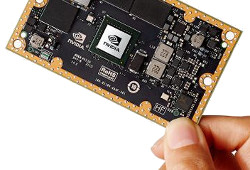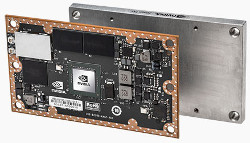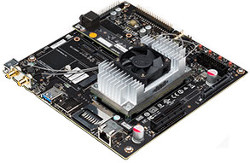Nvidia aims Jetson TX1 module at serious AI and robotics
Nov 11, 2015 — by Eric Brown 4,112 views Nvidia has launched an AI and robotics oriented “Jetson TX1” module and development kit, based on an Nvidia Tegra X1 SoC running Linux.
Nvidia has launched an AI and robotics oriented “Jetson TX1” module and development kit, based on an Nvidia Tegra X1 SoC running Linux.
For its encore to the popular Jetson TK1 hacker and prototyping SBC based on the Cortex-A15 Tegra K1 SoC, Nvidia’s Jetson TX1 has moved to the 64-bit, quad-core, Cortex-A57 Nvidia Tegra X1 SoC. Nvidia has split the product into separately available computer-on-module and COM/carrier development board products.


Nvidia Jetson TX1 module
(click images to enlarge)
The 87 x 50mm Jetson TX1 can generate 1 teraflops of performance, drive 4K 60Hz video decode and 4K 30Hz encode, and handle six camera inputs at up to 1400 megapixels per second, says Nvidia. The development kit will open for preorders on Nov. 12 at $599, with shipments beginning within the week, while the module-only product will go on sale in Q1 2016 for $299 in 1K quantities.
 Jetson TX1 dev board |
Nvidia’s sandwich-style development board approach is somewhat similar to what Intel has done with its Edison module, which is available separately for volume production runs, but can also be purchased with various carrier board options aimed at hackers. While the Edison targets low-end Internet of Things devices, the TX1 aims for the higher level machine learning, vision processing, and autonomous robotics market.


Nvidia Jetson TX1 and its companion heatsink
(click images to enlarge)
Jetson TX1 applications are said to include drones, robots, ADAS driving systems, and mobile medical imaging devices. With its capability for processing “deep neural networks,” the device can handle machine learning tasks such as “recognizing images, processing conversational speech, or analyzing a room full of furniture and finding a path to navigate across it,” says Nvidia. The chipmaker also notes the potential for “drones that don’t just fly by remote control, but navigate their way through a forest for search and rescue; compact security surveillance systems that don’t just scan crowds, but identify suspicious activity; and robots that don’t just perform tasks, but tailor them to individuals’ habits.”
— ADVERTISEMENT —
The sandwich-style design may have been motivated by the surprising way customers have used the Jetson TK1. According to AnandTech, the TK1 was intended primarily as a prototyping board for developers working with Tegra K1 designs, but it has been increasingly used as a plug-in, COTS production board for small runs.
According to AnandTech, the Tegra SoCs have not fared very well in their intended market for tablets, but have caught fire in other embedded applications, including machine learning applications that take advantage of Nvidia’s powerful, 256-core Maxwell GPU and CUDA libraries for everything from augmented reality to autonomous drones. This reflects the changing focus for GPUs from multimedia to artificial intelligence, a trend that is explored in an interesting Nov. 10 Wired story on Google’s open sourcing this week of its TensorFlow AI engine. TensorFlow depends heavily on GPUs such as Nvidia models for parallel processing.
The Linux-based Jetson SDK that ships with the module and development kit includes Nvidia’s growing library of tools that unlock its CUDA GPU architecture to move beyond multimedia to various parallel processing and machine learning tasks. The SDK includes the following components:
- cuDNN (Nvida CUDA Deep Neural Network — CUDA 7.0-accelerated library for deep learning, compatible with industry-standard deep learning frameworks for training and inference, including Caffe, Theano, and Torch
- VisionWorks — CUDA 7.0-accelerated library and framework for computer vision, an implementation of OpenVX 1.1 with Nvidia extensions
- Drivers.APIs — latest graphics drivers and APIs, including OpenGL 4.5, OpenGL ES 3.1, and Vulkan
The Jetson TX1 module is equipped with 4GB LPDDR4, 16GB eMMC flash, and support for WiFi-ac and Bluetooth. There’s also a GbE controller and a 400-pin expansion connector to the Jetson carrier board.
Specifications listed for the Jetson TX1 module include:
- Processor — Nvidia Tegra X1 SoC:
- 4x Cortex-A57 cores
- 256x Nvidia Maxwell/CUDA cores
- 4K 60Hz video decode, 4K 30Hz encode
- Memory — 4GB LPDDR4 RAM (25.6 GB/s); 16GB eMMC 5.1 flash
- Wireless — 802.11ac; Bluetooth
- Networking — Gigabit Ethernet controller
- Other I/O (via 400-pin connector)
- Dimensions — 87 x 50mm
- Operating system — Linux SDK
Jetson TX1 development kit
The Jetson TX1 development kit combines the module with a carrier board that adds features like an SD slot, M.2 (SATA) storage, and a Gigabit Ethernet port. The board is further equipped with USB 3.0 and micro-USB 2.0 ports, an HDMI port, and multimedia interfaces including DSI and CSI. Other features include four PCIe interfaces, and I/O including UART, GPIO, I2C, I2S, and SPI.


Nvidia Jetson TX1 development kit (left) and board assembly
(click images to enlarge)
Specifications listed for the Jetson TX1 Development Kit include:
- Processor/memory — Nvidia Tegra X1 with 4GB DDR4, 16GB eMMC, WiFi, BT (via TX1 module)
- Storage:
- Full-size SD slot
- SATA interface (data and power)
- M.2 Key E interface
- Display/multimedia:
- HDMI port
- 2x DSI interfaces
- DP 1.2 interface
- eDP 1.4 interface
- CSI interface — for up to 6x cameras @ 1400 megapixels per second
- Wireless — WiFi antennas
- Networking — Gigabit Ethernet port
- Other I/O:
- USB 3.0 host port
- Micro-USB 2.0 port (host and recovery modes)
- 3x TTL UART with flow control
- GPIOs
- 4x I2C
- 4x I2S
- 3x SPI
- Expansion — 4x PCIe Gen 2 x1 interfaces
- Other features — Power, reset, force recovery, and user buttons
- Power — Optional external 19V AC adapter
“NVIDIA’s Jetson TX1 is so powerful and easy to use, we decided to base MIT’s robotics systems and science course around it,” stated Sertac Karaman, MIT professor of aeronautics and astronautics. “Our students will use TX1 for embedded vision, stereo reconstruction and machine learning, so their scale racecars will be able to detect and avoid obstacles.”
“Based on BDTI’s independent analysis, the Jetson TX1 stands out in three respects,” stated Jeff Bier, president of Berkeley Design Technology, Inc. “First, developing applications on the Jetson TX1 feels more like developing on a PC than like developing on a typical embedded board. Second, the JetPackTX1 installer makes it easy to install a system image on the board. Third, support for CUDA enables developers to use the GPU to accelerate their applications without having to delve into the complexities of GPU programming.”
Further information
The Jetson TX1 development board will open for preorders in the U.S. on Nov. 12 at $599, with shipments beginning by Nov. 16. International sales will follow. The Jetson TX1 module will go on sale in Q1 2016 for $299 in 1K quantities. More information may be found on Nvidia’s Jetson TX1 product page.

Please comment here...